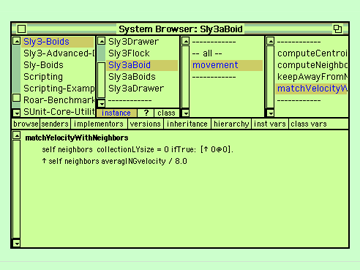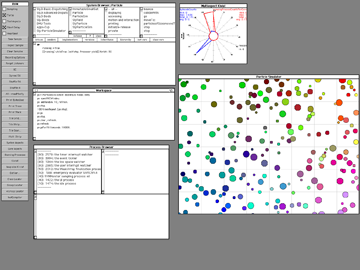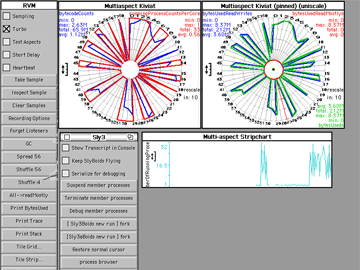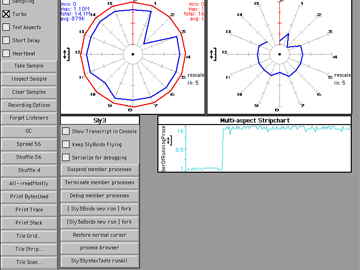Brief Introduction to Sly
"numbers and squaredNumbers are ensembles
indicate with the % sign.
Sending a message to them will cause
all members to evaluate the message,
ideally in parallel."
numbers := Sly3Ensemble
withMembersFrom: {1. 2. 3. 4. 5}.
squaredNumbers := numbers squared.
"squaredNumbers = %{1. 4. 9. 16. 25.}"
"Gerunds modify a function
to be a reduction operation"
%{true. true. false. true} andING
"Need a cartesian product?
The RoundLy adverb will execute the plus
by iterating over the operands"
%{1. 2. 3} plusRoundLY: %{10. 20. 30}
"For more examples, see Sly3SyntaxTests
in the Sly3 image."
Browser newOnClass: Sly3SyntaxTests class
Additional Material
Everything You Know (about Parallel Programming) Is Wrong!: A Wild Screed about the Future
Invited talk at DLS'11, SPLASH'11 by David Ungar |
 |
 |
Harnessing emergence for manycore programming: early experience integrating ensembles, adverbs, and object-based inheritance
David Ungar and Sam S. Adams, IBM Research
©ACM, 2010. This is the author's version of the work.
It is posted here by permission of ACM for your personal use.
Not for redistribution.
The definitive version was published in proc. of SPLASH'10. |
 |
 |
Inconsistency Robustness for Scalability in Interactive Concurrent‑Update In-Memory MOLAP Cubes
David Ungar, Doug Kimelman, and Sam Adams, IBM Research
The work was published in proc. of the Inconsistency Robustness 2011 Symposium. |
 |
 |
Building the RoarVM form Source Code
## Setting up and running the RoarVM on *nix-like Systems
cd /tmp # moving somewhere safe
# Get the VM code from github
git clone --depth 1 git://github.com/smarr/RoarVM.git
cd RoarVM
# Read the INSTALL.rst file and make sure all prerequisites are meet
open INSTALL.rst || less INSTALL.rst
cd vm/build
./configure
make -j -l 1.5 # those parameters let make use all your cores
# optionally, install it: sudo make install
# get the latest image
cd ../run
wget http://soft.vub.ac.be/~smarr/roarvm/Sly3.zip
unzip -j Sly3.zip
# Start the VM using 2 cores and 512 heap
../build/rvm -num_cores 2 -min_heap_MB 512 renaissance.image
Additional Material
The Sly3 Programming Language
An introduction and analysis by Pablo Inostroza Valdera |
 |
 |
Guide to the Optimizations of the Sly3 Evaluation Mechanism
Project report by Pablo Inostroza Valdera
(release pending) |
 |
|
Hosting an object heap on manycore hardware: an exploration
David Ungar and Sam S. Adams, IBM Research
©ACM, 2009. This is the author's version of the work.
It is posted here by permission of ACM for your personal use.
Not for redistribution.
The definitive version was published in proc. of DLS'09. |
 |
 |
Multiprocessor Smalltalk: a case study of a multiprocessor-based programming environment
Joseph Pallas and David Ungar, Stanford University |
 |
|
What next?
The RoarVM is a research virtual machine, and the main goal is
to make it easy to experiment with new VM techniques and languages.
Thus, the RoarVM is not optimized for performance.
For the Smalltalk community as a whole, the approach with the most
long-term benefit would be to integrate the techniques tested in the
RoarVM into the standard SqueakVM and the Cog just-in-time compiler.
To facilitate an integration, the RoarVM uses the same code base:
- Fully Compatibility: load and save images from the CogVM, StackVM, Standard interpreter + RoarVM
- Tracking Upstream changes with Git
integrate-with-upstream
- Compatible with standard plugins
- The RoarVM can just replace
interp.c
The iPad version of the RoarVM uses the standard Squeak iOS code,
and replaces just the interpreter.
Ok, we also added some code to be able
to handle input in our images, but it is still Squeak-compatible!
RoarVM on the iPad2 with two cores!
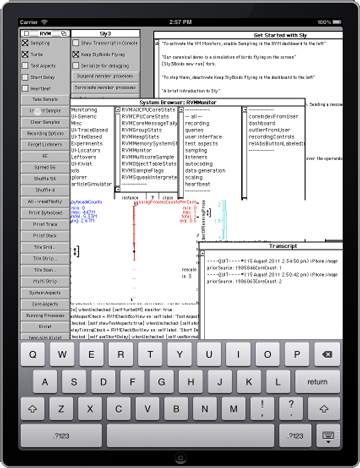
Retrospect
The Renaissance project
started in IBM Research and after involving
Andrew P. Black from the Portland State University
and Theo D'Hondt from the Vrije Universiteit Brussel
it became an open source project.
In November 2010, IBM Research
released the source code
of the RoarVM and the Sly language implementation
officially under the Eclipse Public License to invite
feedback and participation in the project.
SPLASH'10 Birds of a Feather
The main question, can we use non-deterministic programming to solve
today's concurrency problems, was discuss during a birds of a feather
meeting at SPLASH 2010.
Project Infrastructure
Involved People
- Sam S. Adams
- David Ungar
- Doug Kimelman
Portland State University
Andrew Black
- Andrew P. Black
- Max OrHai
- Theo D'Hondt
- Stefan Marr
- Pablo Inostroza Valdera
- Mattias De Wael
- Reinout Stevens
- Wouter Amerijckx
Smalltalk Goodies
SMark is the attempt to build a common benchmarking framework for Smalltalk.
It inspired from the metaphor used for unit testing in SUnit, and thus,
a benchmark is implemented by adding #benchMyBenchmark to a subclass of SBenchmarkSuite.
The code is originally based on PBenchmark
the benchmark framework used
for the PinocchioVM
and RoarBenchmark a framework used for performance regression testing
of the RoarVM.
Since the Renaissance project started from a minimal Squeak image
without support for Monticello, we needed a structured way to manage
our source code.
Transporter is a tool to file out code into standard Squeak file-out
format and aid it with a very basic package semantics to
enable efficient source code management using Git or other file-base
version control systems.
Virtual Machine Goodies
Not yet completely ready, but on a good way (just one bug left!) is
a new garbage collector for the RoarVM. It is inspired by Cliff Click's
Pauseless GC Algorithm
and thus, will provide a scalable way of garbage collection that avoids
global synchronization which interrupts all cores.
Avoiding global synchronization is key to performance on systems with more than
64 cores. The RoarVM will be the first open-source interpreter VM which
comes with such a pauseless GC.
Another limitation for scalable fine-grained parallelism on the RoarVM
is its global scheduler. This project brings a work-stealing-based
scheduler to the RoarVM to have better scalability for Sly's fine-grained
parallelism, or to facilitate fork/join-like usage of the standard
Smalltalk.
ReBench is our tool to execute the virtual machine benchmarks.
Fully integrated with our Codespeed instance allows ReBench us
to continuously track the performance of the RoarVM.
Application for the Innovation Technology Awards
Hereby, we, the whole Renaissance team, would like to apply for the ESUG Innovation Technology Awards 2011.
Name of the Software: Sly and the RoarVM: Exploring the Smalltalk Manycore Future
License information: Sly and the RoarVM are open source under the Eclipse Public License
Team: We are students and full-time researches from IBM Research, Portland State University, and Vrije Universiteit Brussel. Please see the project section for details.
Downloads: please see the downloads section.
We are open for your feedback. Please ask us if you have any questions
on how to use the RoarVM, or how to use Sly.
The VM-dev mailinglist
is one way to reach us. Other options are to follow us on
Twitter @roarvm or
watch and fork us on GitHub.
Another option is to use Disqus to leave us your feedback below.





